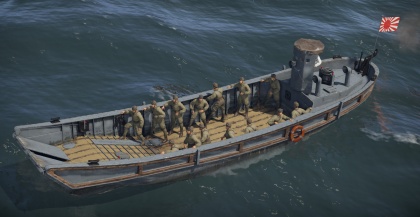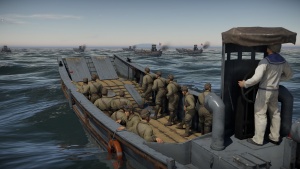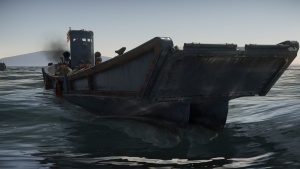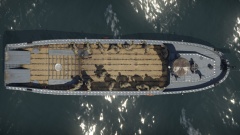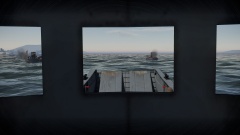Daihatsu-class Landing Craft
Contents
A Japanese Daihatsu-class Landing Craft is an AI-controlled naval unit, playing a role of one of the goals in a number of missions, either to protect or destroy. Among others it was used in the Battle of Luzon during the Season: Attack from the Sea. In the game itself the boat is marked only as the "Landing Craft", however its full name is being used in an in-game files (being marked as jp_daihatsu_landing_craft).
General info
Survivability and armour
Landing Craft is easy to destroy even with a low calibre machine guns. It's protected by 4mm of rolled homogeneous armour on the hull, which is not enough to prevent its destruction from a direct hits. It is, however, one of the smallest naval targets in the game. Occasionally one can find less experienced pilots unloading an entire magazine right under or over the boat, thinking that the bullets scored hits, while in reality Landing Craft continues unscratched.
Daihatsu exists in a two versions, standard and light, they're otherwise indistinguishable, but the light variant has half the survivability of it's heavier equivalent.
Mobility
The boat has a maximum speed of 80 km/h and the 5 km/h reverse. In game boats are either stationary, or follow pre-determined path in a straight line and equal speed, making for a very predictable targets, even for the high altitude bombers.
Armament
Primary armament
Defence is provided by a single 12mm machine gun that will engage targets up to 1000m away, providing a perfect coverage of 360° horizontal, +90°/-10° vertical, in effect having no blind spots. Machine gun will shoot even through the boat with no negative effect. It's firing a magazine full of yellow tracer rounds with a significant spread. While a lone boat poses little threat, Landing Crafts are always moving in a group, mutually covering each other, what might lead to kills against less careful airplanes.
| Ammunition | Bullet | Penetration in mm @ 0° Angle of Attack | ||||||
|---|---|---|---|---|---|---|---|---|
| mass | speed | 10m | 100m | 500m | 1000m | 1450m | 1500m | |
| Tracer | 42 g | 860 m/s | 16 | 13 | 8 | 6 | 0.1 | 0 |
Usage in battles
AI target boats are used primarily as an objectives, with Landing Crafts being the most basic AI-controlled naval unit. They're used in a low-rank battles, not requiring anything but a basic machine gun every reserve unit has to destroy it. In a World War missions they are being used for the fleet Convoy encounters.
Pros and cons
Pros:
- Small size
- Armed swarm
Cons:
- Extremely inaccurate gun
- No survivability to speak of
History
Daihatsu-class Landing Craft (大発動艇, Daihatsudōtei, translated: Large Powered Boat) was a landing craft of the Imperial Japanese Army, originally developed in 1924, further refined later on and also adopted to the Imperial Japanese Navy service.
Boats were first used in combat on 29 February 1932, during the Shanghai incident landing IJA's 11th Division behind enemy lines blocking enemy from receiving supplies and reinforcements that lead to a withdrawal of the Chinese 19th Route Army. This operation was studied carefully by US intelligence, with photographs of the boats provided to the Andrew Higgins who copied the design into LCVP.
Landing crafts were built till the end of World War 2, with one of the last reported combat uses being a supply delivery on the Kaladan River. It took place on 10 May 1944, as a part of the U Go offensive (Burma campaign), where boats were camouflaged with bushes and armed with Type 92 heavy machine gun. It's estimated that 6000 boats were built for both: Army and Navy.
Nowadays two sunken Daihatsu landing boats are available as a scuba diving attractions on the Maritime Heritage Trail in the Saipan lagoon.
Variants
Four primary types of the boat existed:
- Type A (A型, 1925) - spoon bow, either without (early models) or with ramp (late models)
- Type B (B型, 1930) - stepped spoon bow, more powerful engine
- Type C (C型, 1930) - W-shaped bow (characteristic two ridges)
- Type D (D型, 1935) - reinforced to be able to carry armoured vehicles, this is the iconic variant with highest production numbers, the one in the game.
Furthermore, a number of derivatives were produced, such as 木製大発動艇, the Large Wooden Boat.
Interestingly, boats were very heavily modified, both: by the shipyards and in the field by soldiers. Engines were never standardized, being changed depending on manufacturer, time and even swapped by crews, however roughly 60 hp diesel engines were the most common. Additional armor was added, either welded on the hull or attached by other means. Boats were also armed, some of the most notable weapons mounted on Daihatsus included:
- Type 96 25mm anti-aircraft gun (九六式二十五粍高角機銃) - up to three, single-mount on an individual boat
- Type 94 37 mm anti-tank gun (both, naval and army variants were used)
- Type 38 75mm field gun (三八式野砲)
- Type 96 150 mm howitzer (九六式十五糎榴弾砲)
- Type 4 20cm rocket mortar (四式二十糎噴進砲) - launcher mounted on a designated mount, with boat being designated as 20糎噴進砲大発動艇 (literally: the large powered boat carrying 20cm rocket launcher)
- Up to 2 torpedoes (Type 2, Type 44, Type 91 Mod 3) released sidewise, mounted either near centre of the mass or towards rear of the boat.
Design
Daihatsu Type D was a welded-steel, hard chined monohull design with a total length of 14.8 m, a width of 3.3 m and a mass of 9.5 tonnes for an average draft of 90 cm. It could load up to 13 tonnes of cargo, reaching a speed of 7 knots (13 km/h) fully loaded. Its operational range was up to 190 km.
W-shaped bow assisted in on-shore operations, where ridges bite into the sand or pebbles of the beach allowing for smooth unloading despite waves, in particular for armoured vehicles and supplies. Similarly, it enabled easier retreat, as the boat did not have to beach so far inland.
Boat's armour protected occupants from a direct machine gun fire, with a reports of surviving even a 40 mm Bofors hits. However, due to boat's very small size and high manoeuvrability they were a difficult targets, making such reports rather questionable, with near misses or ricochets being more likely scenario.
Design specifications for the Type D called for a capacity of 90 soldiers, 10 horses or a single Type 89 I-Go medium tank. With a mass of 12.8 tonnes it defined the maximum carry capacity. Throughout the war other armed vehicles were also transported by the IJA, notably Type 95 Ha-Go light tanks or the Type 97 trucks.
Media
See also
Links to articles on the War Thunder Wiki that you think will be useful for the reader, for example:
- reference to the series of the ship;
- links to approximate analogues of other nations and research trees.


